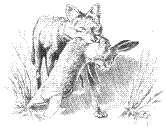Center, Internet, Wildlife Damage Management

Coyotes in the Southwest: A Compendium of Our Knowledge (Symposium Proceedings, 1995)
Date of this Version
January 1995
Document Type
Proceeding
Citation
Published in Coyotes in the Southwest: A Compendium of Our Knowledge, Symposium Proceedings, December 13–14, 1995, San Angelo, Texas
Edited by Dale Rollins, Calvin Richardson, Terry Blankenship, Kem Canon, and Scott Henke
Abstract
The coyote (Canis latrans) population in southern Texas has a recurring group of 3 common helminths and several peripheral species of lesser importance. Although recurrent group analyses have not been applied to other macro- or microparasite communities, there are certain infectious agents with high prevalences that could form recurrent groups, and that are potentially important in tams of impacting host population (i.e. coyote) abundance. While the current rabies epizootic involving coyotes in southern Texas is of public health concern, it probably will not have a major impact on the coyote population. Most likely, the net effect of canine rabies will be compensatory with other mortality factors as occurred in other introduced microparasitic (canine distemper virus, canine parvovirus) and periodically recurring macroparasitic (sarcoptic mange) infections that have caused recent epizootics in this coyote population. In contrast, neotatal mortality from hookworm is conjectured to have a possible regulatory effect on the coyote population in southern Texas, but this remains unproven The effects of disease on the host populations should always be considered prior to initiating management or control strategies for any vertebrate species.


Comments
Published 1996, Austin, Texas. Used by permission